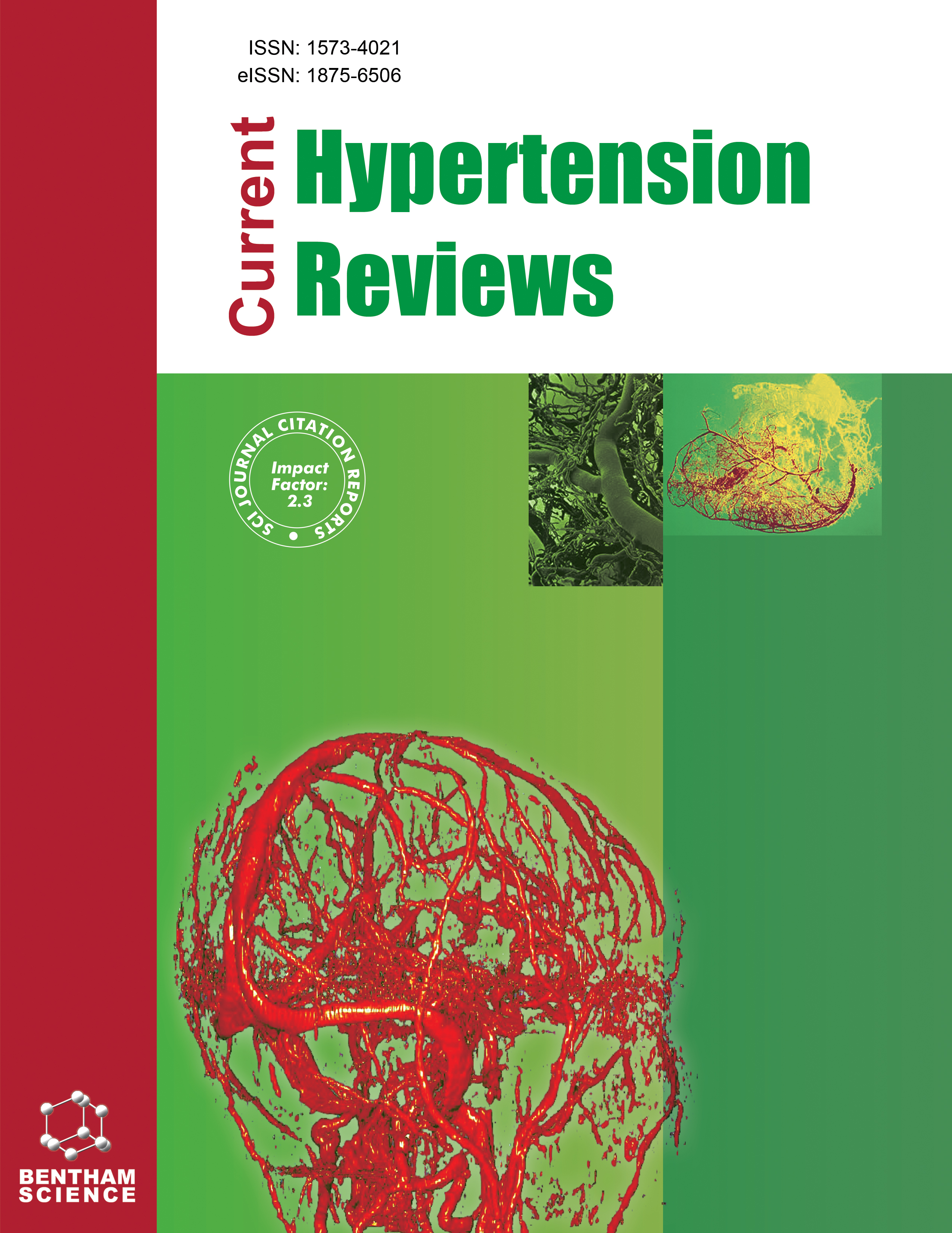- Home
- A-Z Publications
- Current Hypertension Reviews
- Previous Issues
- Volume 9, Issue 1, 2013
Current Hypertension Reviews - Volume 9, Issue 1, 2013
Volume 9, Issue 1, 2013
-
-
Cardiovascular Complications in Autosomal Dominant Polycystic Kidney Disease
More LessBy Tevfik EcderCardiovascular complications are a major cause of morbidity and mortality in patients with autosomal dominant polycystic kidney disease (ADPKD). Hypertension is a common finding of ADPKD occurring in 50-70% of patients before the impairment of renal function. Stimulation of the renin-angiotensin-aldosterone system plays a major role in the development of hypertension in ADPKD. Hypertension is associated with an inc Read More
-
-
-
Renin-Angiotensin-Aldosterone System in Autosomal Dominant Polycystic Kidney Disease
More LessAuthors: Oleksandra Tkachenko, Imed Helal, Dmitry Shchekochikhin and Robert W. SchrierAutosomal dominant polycystic kidney disease is the most frequent life-threatening hereditary disease. Prognostic factors for progressive renal impairment have been identified such as gender, race, age, proteinuria, hematuria, hypertension. Hypertension is the only risk factor for renal dysfunction in autosomal dominant polycystic kidney disease, which is presently treatable. Better understanding of the pathophysiology Read More
-
-
-
Hypertension in Children with Autosomal Dominant Polycystic Kidney Disease (ADPKD)
More LessAutosomal dominant polycystic kidney disease (ADPKD) is the most common hereditary renal disease, affecting 1 in 1000 individuals. Previously termed “adult polycystic kidney disease”, ADPKD is now known to have important clinical manifestations beginning early in life and even in utero. Hypertension is an important risk factor for progressive renal and cardiovascular disease in children with ADPKD and may signify irreme Read More
-
-
-
Left Ventricular Hypertrophy in ADPKD: Changing Demographics
More LessAuthors: Ahsan Alam and Ronald D. PerroneLeft ventricular hypertrophy (LVH) has been recognized as an early and important complication in patients with autosomal dominant polycystic kidney disease (ADPKD). LVH is associated with arrhythmias, congestive heart failure, and increased cardiac mortality. The increase in left ventricular mass is attributed to the compensatory myocardial remodeling associated with systemic hypertension, which is also highly pr Read More
-
-
-
Endothelial Dysfunction and Angiogenesis in Autosomal Dominant Polycystic Kidney Disease
More LessAutosomal dominant polycystic kidney disease (ADPKD) is the most common potentially lethal hereditary disease. The hall mark of the disease is the development of innumerable cysts in kidneys and liver. However, a vascular phenotype including the early occurrence of hypertension, abnormalities in renal blood flow, intracranial and aortic aneurysms, spontaneous coronary and cervicocephalic artery dissections, and Read More
-
-
-
The Genetics of Vascular Complications in Autosomal Dominant Polycystic Kidney Disease (ADPKD)
More LessAuthors: Sandro Rossetti and Peter C. HarrisThe most important extra-renal manifestation of autosomal dominant polycystic kidney disease (ADPKD) in terms of debilitating injury and premature death is the development of intracranial aneurysms (IAs) and other vascular complications, resulting in subarachnoid hemorrhage (SAH). IAs are found at a rate approximately five times higher in ADPKD patients than in the general population and in patients with a fa Read More
-
-
-
Experimental Therapies and Ongoing Clinical Trials to Slow Down Progression of ADPKD
More LessAuthors: Maria V. Irazabal and Vicente E. TorresThe improvement of imaging techniques over the years has contributed to the understanding of the natural history of autosomal dominant polycystic kidney disease, and facilitated the observation of its structural progression. Advances in molecular biology and genetics have made possible a greater understanding of the genetics, molecular, and cellular pathophysiologic mechanisms responsible for its development Read More
-
-
-
Does Brachial Blood Pressure Need to Predict Cardiovascular Outcomes in End Stage Renal Disease? An Update
More LessAuthors: Serena Torraca, Salvatore Palmese, Maria L. Sirico, Lucia Di Micco, Paolo Salvi and Biagio Di IorioHypertension is responsible for a significantly increased burden of cardiovascular events and it is cause and a consequence of Chronic Kidney Disease (CKD) and a determinant factor in its progression to End Stage Kidney Disease (ESKD). Therefore, nephrologists have been focusing their attention on hypertension control to prevent CKD progression, delaying it but with poor results on cardiovascular mortality reduction. An Read More
-
-
-
Evaluation of Blood Pressure Control using a New Arterial Stiffness Parameter, Cardio-ankle Vascular Index (CAVI)
More LessArterial stiffness has been known to be a surrogate marker of arteriosclerosis, and also of vascular function. Pulse wave velocity (PWV) had been the most popular index and was known to be a predictor of cardiovascular events. But, it depends on blood pressure at measuring time. To overcome this problem, cardio-ankle vascular index (CAVI) is developed. CAVI is derived from stiffness parameter β by Hayashi, and the Read More
-
-
-
The Role of the Immune System in the Pathogenesis of Hypertension
More LessAuthors: Vincent W.S. Lee, Yiping Wang and David C.H. HarrisThe role of innate and adaptive immunity in the pathogenesis of hypertension has received increasing recognition over the past few years. This review will focus on recent developments in this emerging area. In particular, the role of macrophages and lymphocytes will be highlighted.
-
Volumes & issues
-
Volume 21 (2025)
-
Volume 20 (2024)
-
Volume 19 (2023)
-
Volume 18 (2022)
-
Volume 17 (2021)
-
Volume 16 (2020)
-
Volume 15 (2019)
-
Volume 14 (2018)
-
Volume 13 (2017)
-
Volume 12 (2016)
-
Volume 11 (2015)
-
Volume 10 (2014)
-
Volume 9 (2013)
-
Volume 8 (2012)
-
Volume 7 (2011)
-
Volume 6 (2010)
-
Volume 5 (2009)
-
Volume 4 (2008)
-
Volume 3 (2007)
-
Volume 2 (2006)
-
Volume 1 (2005)
Most Read This Month
Article
content/journals/chyr
Journal
10
5
false
en


